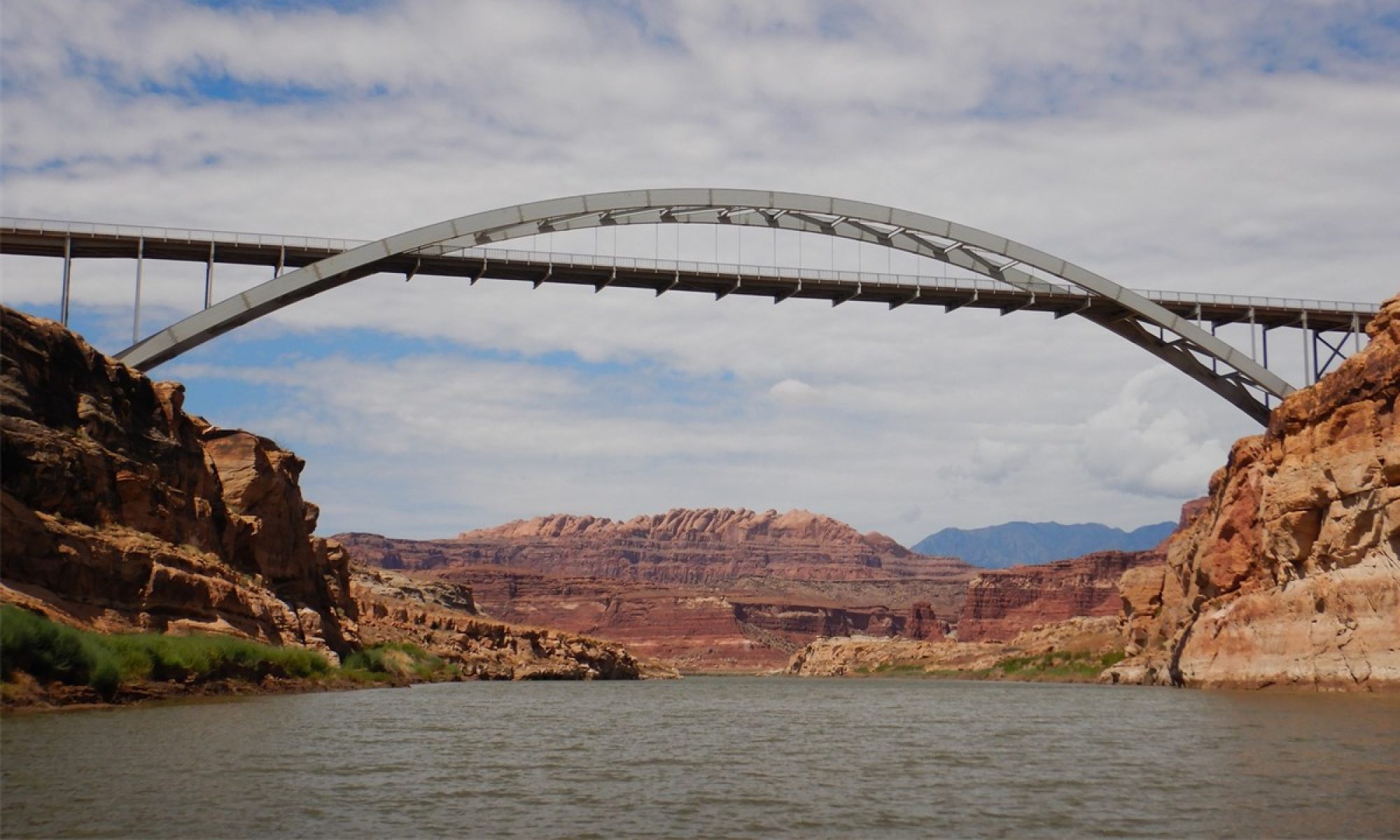August September 2019
After four sightseeing-filled days in Paris, Thursday morning, August 29th, 2019, saw us meeting our bicycling travel group in the lobby of the Balmoral Hotel. The 23 of us were met by two of our four Backroads Guides, Otis & James, and we proceeded to load our luggage and ourselves onto a large motor-coach and head west out of the city to a farm where we were fitted to our bikes, received a safety lecture, and began our first ride to Versailles for lunch. Of the 23 in our group, 12 had e-bikes (battery/electrically assisted), and 11 had “regular” bikes. Now, by “regular” bikes, I mean Backroads’ custom titanium and carbon-fiber-frame bikes with electronic shifting! Bikes that are certainly well out of my price-range to purchase! In our little group of four, the two boys were on regular bikes, and the two girls had e-bikes. The ride to Versailles was short (~9-miles) but was a good chance to get used to our bikes and make sure everything was okay. Unfortunately, not everyone had as smooth of a ride as we did, and a few spills and bruises were already collected. Lunch was in the gardens of Versailles, very much near where we ate lunch during our visit two days before. After lunch, we rode another 8-miles through a national forest and a state park to a viewpoint overlooking Paris. From here, we could see the landmark weather balloon that rises over Paris daily, and were informed that our Riverboat was located at the base of it. For those who chose to do so, we rode the additional 8-miles into Paris – dodging the tourists and pedestrians – and making our way to the wharf where the AmaLyra was located. For those who chose to take the van from the overlook, wine, beer and snacks were readily available. Once there, Backroads retook possession of our bikes, and we checked into our lovely upper-level staterooms, complete with balconies and sliding glass doors. After showers, we toured the decks of the ship before meeting in the lounge at 6:00pm for “Welcome-Aboard” drinks and meeting the Captain (“Jackie”) and crew. Our Captain was from Romania, was 32 years old, and had “cut his teeth” on tugs and commercial boats. This would be his first voyage as Captain of this riverboat! Most of the crew was either French, Romanian or Portuguese. There were ~120 passengers on the boat, and our group, the most adventurous aboard, numbered 25 in total with our guides. Dinner was in a lovely dining room and included free-flowing wine and beer. After dinner, we all went up on-deck to say good-bye to the lights of the city, to observe the wheelhouse move up and down to fit under bridges, and to get to know our fellow passengers. That night we socialized on-deck until ~11:30pm and enjoyed the French wine and the beautiful warm summer evening.



Friday morning, we arose at 6:30am for breakfast, and then disembarked the boat in the town of Vernon. Here, we met our other two Backroads Guides, Carlos and Clem, and boarded our bikes for a 13.4-mile ride to the town of Les Andelys. As we began, the boat left to join us downstream. After getting out of the town’s traffic, the ride was quiet and pleasant along parts of the Seine River and through the local countryside. Upon arriving in Les Andelys, we grabbed a couple of snacks and had the option to either ride a 19-mile hilly loop back to town or take a guided tour of the ruins of Chateau Gaillard – the castle stronghold of Richard-the-Lionhearted. Rocky took the tour while the other three of our group rode the loop. The loop started with a 450-foot high hill and a gently rolling ride through the countryside. The tour of the castle was led by Natale and explained that this large portion of what is today, France, was once ruled by Richard-the-Lionhearted, who was simultaneously King of England and feudal Duke of Normandy. In the 1180’s, The King of France struck and alliance with Richard to join the Crusades to free Jerusalem. While Richard was gone, his brother, Prince John would rule in his stead, (remember the stories of Richard, Prince John and Robin Hood!) After battling at the Crusades, the King of France returned home to France, and began to make a deal with Prince John for annexing Richard’s lands. The immensely popular Richard arrived back in time to stop the transfer, but decided that the French could not be trusted, and set forth to build a fortress castle on the banks of the Seine to give warning to any French attack from Paris. The castle was built high on the limestone cliffs above Les Andelys and used a novel design of curved walls that was a learning of Richard’s from his failed assaults in Jerusalem. Construction began in 1196 but was competed in just two years in 1198. Château Gaillard has an advanced design and uses early principles of concentric fortification. The castle consists of three enclosures separated by dry moats, with a keep in the inner enclosure. Unfortunately, in 1199 Richard was wounded in Limoges by an arrow to the shoulder from which he subsequently died, and the region slowly fell under strong French influence. Château Gaillard was captured in 1204 by the king of France, Philip Augustus, after a lengthy siege. In the mid-14th century, the castle was the residence of the exiled David II of Scotland. The castle changed hands several times in the Hundred Years’ War, but in 1449 the French king captured Château Gaillard from the English king definitively, and from then on it remained in French ownership. Henry IV of France ordered the demolition of Château Gaillard in 1599; although it was already in ruins at the time. It was designated a “quarry” and many of its stones were taken and used to build the local towns and villages. From here, the tour visited the town of Les Andelys, and the flying-buttressed church that anchors the town. After the tour, and upon the return of the loop-riders, we were visited by Madame Micheline and Monsieur Jaques Renaut who offered us the opportunity to taste some authentic Normandy treats. We started with their homemade “pommeau” – a sweet apple liquor and enjoyed a 100-year-old recipe for a neufchatel cheese and savory bacon-pea muffins. After that, the Amalyra was ready for us to re-board in time for a lunch of escargot and baked trout. The afternoon was spent cruising down the Seine through a series of locks. Before dinner, our Backroads group met at the Chef’s Table Room for wine and cheese and individual introductions, and then adjourned to dinner and a night on the dance floor.
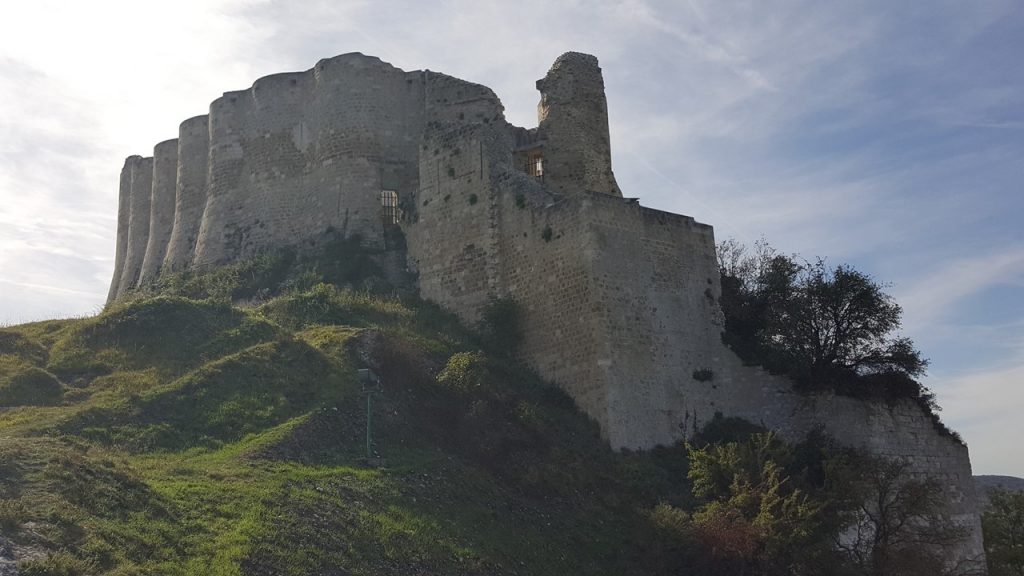
Saturday morning, the ship arrives and docks in the port city of Le Havre and moors at the Quay of Marseille. Le Havre was completely destroyed by the Allied Bombing of World War II, but today is completely rebuild with innovative uses of concrete. We get to sleep-in as we meet with our group and disembark at 9:30am. From here, we take a short bus ride to the other side of the estuary where we board our bikes and ride 9.1-miles west through the countryside of Marais Vernier past thatched-roof houses to a small coffee shop operated by a southern French lady with Spanish ancestry who you would not want to cross! But she makes a spectacular cappuccino! From here, we ride another 6.1 miles to La Cremaillere where Monsieur and Madame Delaunay welcome us for lunch. We are served a delicious fish with carrots and broccoli, finished off by an apple tart and apple gelato. After lunch, we continue our ride for another 11.8 miles to the colorful port city of Honfleur, located downstream and across the estuary from Le Havre at the mouth of the Seine River. Upon arrival, we are met at the Quay with oysters on the half-shell, wine and snacks. Once our group is all assembled, three of us decide to tour town instead of riding the optional additional 14-mile loop. The old port is picturesque with shops and restaurant, an antique merry-go-round, Ferris wheel, and all the enticements of a tourist’s mecca. The Sainte-Catherine church, which has a bell tower separate from the principal building, is the largest church made from wood in France. Honfleur, with no significant targets, was bypassed from the Allied bombing during World War II, and thus survives in its old beauty. We sightsee, shop and enjoy some chocolate crepes before catching the bus to cross the estuary and re-join the ship in Le Havre. Since the ship is staying docked overnight in Le Havre, we take advantage to explore the town and go ashore for dinner. There is a festival going on in town, but we find a popular Italian restaurant, La Lucciola, where we enjoy pizza, beer and wine – some of the best pizza we have ever had! After dinner, we wander back to the ship and enjoy a nightcap before turning in.
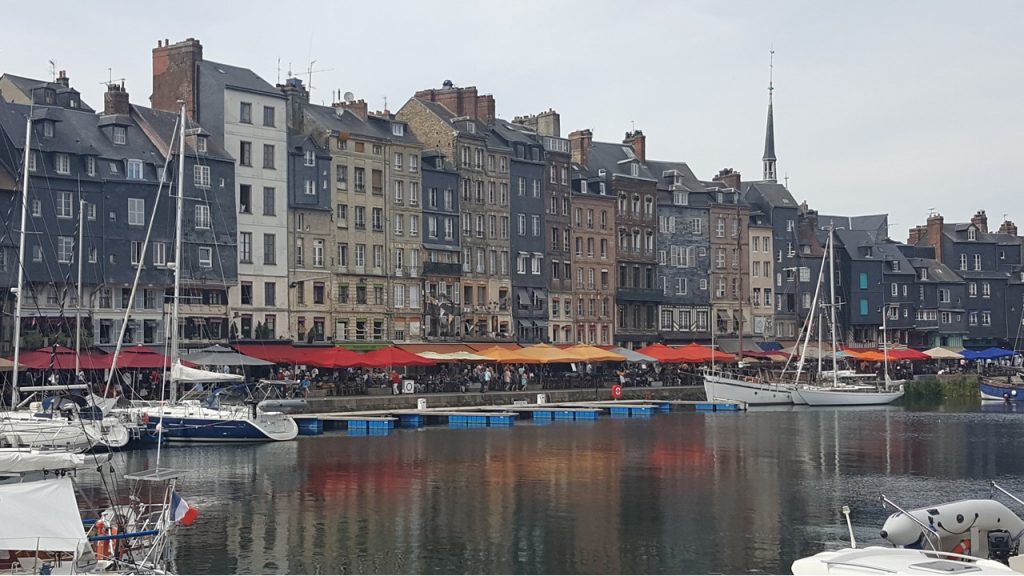
It is now Sunday, September 1st, and we arise early for breakfast and disembark the ship for a 2-hour bus ride to the Normandy Beaches. Upon arriving at the American Memorial and Cemetery at Omaha Beach, we meet our guide for a 2-hour walk tour of the German bunkers and encampments, the American Memorials, and the American Cemetery. It is a moving day trying to imagine the shear will, determination and sacrifice of those young men & women who landed on those shores on D-Day just 75years ago. Shortly before lunch, we climb aboard our bicycles and pedal a mere 7.5 miles down the coast to a small castle, “Chateau d’Asinieres en Bessin”. Carl, the owner, gives us a brief history of the castle from the time it was built in 1672, and then rebuilt in 1783, through World War II to become the Bed & Breakfast that it is today, (it still has its moat!) It turns out that Carl is also a Chef, and he provides us a lunch of smoked duck spring rolls, salads, cheeses and apple compote. Today is also our guide, Clem’s, birthday, and so we have all ridden with balloons on our bikes, sing him “Happy Birthday” and share a bit of cake before setting off again for a 14.5-mile ride through the countryside to an ice cream shop located at a milk farm. After enjoying ice cream, we finish our daily ride with another 15 miles to the town of Bayeux – the old capital city of William The Conqueror. Here is located the world’s longest tapestry, the 1000-year old Bayeux Tapestry displayed in a custom museum. The Tapestry is 70-meters long and depicts the story of William The Conqueror. Across from the Museum stand a 1000-year old waterwheel that still works, and a huge, stark cathedral. After touring the town, we boarded our bus for the short trip back to our ship which has now moved back up-river and is docked in the town of Caudebec-en-Caux. After boarding, we catch a bit of a 1-hour history presentation by Nigel on the D-Day Invasion. Nigel is a Brit, World War II history expert, artist and published author who has lived in Normandy area for decades. When he finishes, the ship sets sail to continue up-river, and we ready ourselves for dinner. And an evening of classical music.



The boat travels during the night and arrives the city of Rouen at about 4:00am. We have breakfast and meet on the Quay at 8:30am to prepare the day’s bicycle ride. Today’s ride begins with a difficult 1.5-mile, 400-foot steep, uphill climb before reaching a plateau and coasting another 4.5-miles along the shores of the Seine River to a local ferry crossing. We arrive at the ferry crossing, but the ferry is having technical difficulties and is testing maneuvers in the river. After a 45-minute wait, the ferry has deemed the difficulties resolved and we board for the short crossing to the other bank. Once there, we relax at a local café for a hot coffee before pedaling another 25-miles along the Seine to another ferry crossing back across the river, and then to the town of Jumieges. Here we enjoy a delightful lunch of salads, fish and squid at a small restaurant and take the opportunity to explore the 7th-Century Auberge des Ruins – the ruins of the Abby of Jumieges! The ruins are remarkable in their stonework, their soaring arches, and their durability. Then, it is time to bicycle back to the ship. Along the way, we stop for a quick snack at the Abby of St. George de Boscherville before completing our 23.4-mile return, including one very substantial hill and arriving back at the quay. Once back, we meet our local town guide, Natalie (again!) and start a tour of the historic sights of the city of Rouen. Much of the old town along the river burned during the Nazi occupation, (45% gone), but much of the other old parts of town survived, including the Gothic Cathedral of Notre Dame, Medieval Clock and Parliament building. The cathedral’s gothic façade was completed in the 16th century and was the subject of a series of paintings by Claude Monet which are exhibited in the Musée d’Orsay in Paris. It did take 2-hits by Allied Bombs, but survived rather unscathed from the war, and was quickly repaired. Down the street, the Gros Horloge is an astronomical clock dating back to the 14th century, of which only a few others have survived, including one in Prague and one in Venice. The city is also known as the site where Joan of Arc was brought in 1431 to be threatened with torture and subsequently burned at the stake. Today, in the center of the Place du Vieux Marché is the modern church of St Joan of Arc. It is a large, modern structure that represents an upturned Viking boat. Nearby stands a cross marking the site where she died. At the end of the tour, we learn that tonight there will be a light show at 9:30pm displayed on the façade of the cathedral. At the tour’s end, we return to the ship for the Captain’ Gala Cocktail Reception and Dinner. After dinner, we stroll back to the Cathedral for the light show and take seats on the surrounding steps to enjoy the ~30-minute show with music and creative animations. Then, back to the ship for night-caps and bed, with the ship disembarking at ~4:00am.
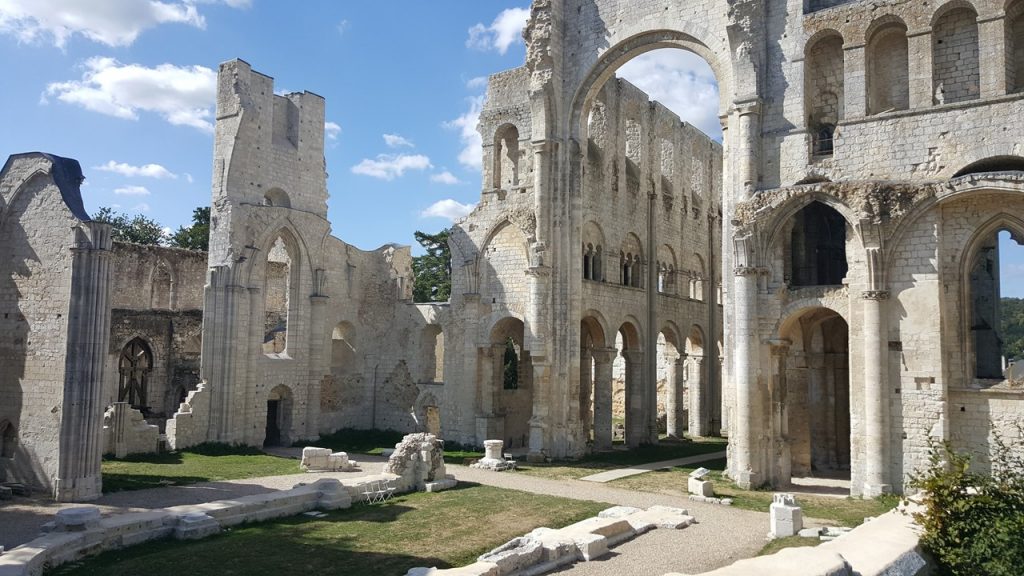
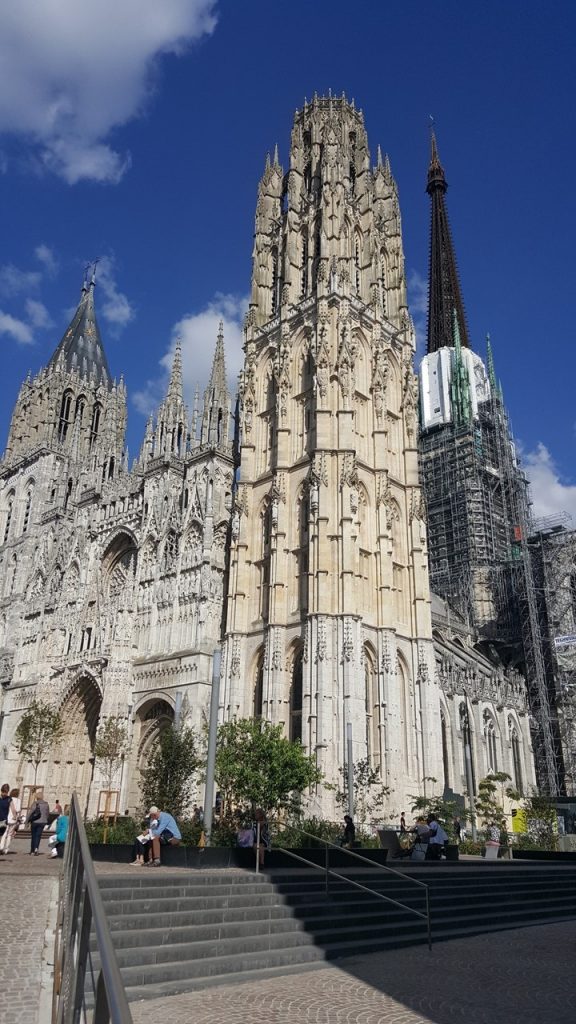
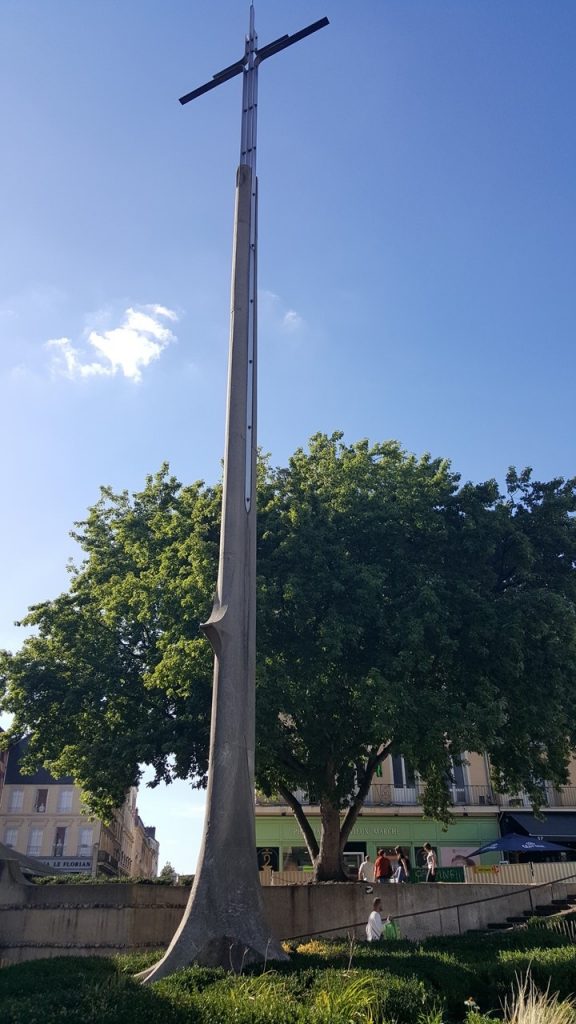
The next morning (Tuesday) the ship is still underway, and so we take a late breakfast and then relax in the ship’s on-deck hot tub. After lounging the morning away, we meet on the sun deck for today’s ride briefing, have a quick lunch, and disembark to our bicycles when the ship docks in the town of Vernon. Vernon was founded in the 9th century but is principally known today as the gateway to Giverny and Monet’s house. We climb on our bicycles and ride the short ~3 miles to Giverny, dismount and enter the gardens of Monet. Monet moved here in 1883 with his wife and 8 children and settled into the green-shuttered pink house known as “The Cider Press”. He was an avid gardener and lived and painted there until his death in 1926. The gardens consist of two parts – the Clos Normand Flower Garden near the house, and the Oriental Water Gardens, that are so famous, located across the street. These gardens were the subject of over 500 paintings by Monet. In 1960, Monet’s son bequeathed the property to France, and it subsequently deteriorated until 1977 when a significant fundraising and restoration effort began. The restored Gardens and home were opened in 1980, and today are carefully tended. We wandered the green-bridge paths around the water-lily ponds, strolled along the small diverted stream, and marveled at the abundance and variety of flowers in the house’s gardens. After visiting the house where the walls are covered by Monet’s works and other of his art interests, we shop in the small gift shop before making our way back to our bicycles and heading off on another 9-mile ride to The Chateau de La Roche Guyon – a medieval castle build into the soaring white chalk cliffs on the banks of the Seine. The extensive rooms at the back of the Chateau that tunnel back into the rock were used by the Germans during World War II for ammunition storage. Today, the castle’s restoration is still underway, but the portcullis, terraces, chapels and a series of lounges, subterranean passages, dungeons and casemates are open to view and wander through. Even the comic author’s, (Edgar Jacobs), “chronoscaphe” is still preserved there in an eerie and strange setting. Then it was time to ride the 18-miles back to the ship for the short sail to La Roche-Guyon and to prepare for drinks, dinner and the evening’s entertainment – a musical tribute to Edith Piaf by singer Caroline Nin. The moving story of Edith’s life told in narrative and song was punctuated by Rocky being taken to the stage to dance and support Caroline’s show. After the show, we joined the guides and Caroline for drinks, stories and laughs before calling it a night, as the ship set sail for Conflans St. Honorine.
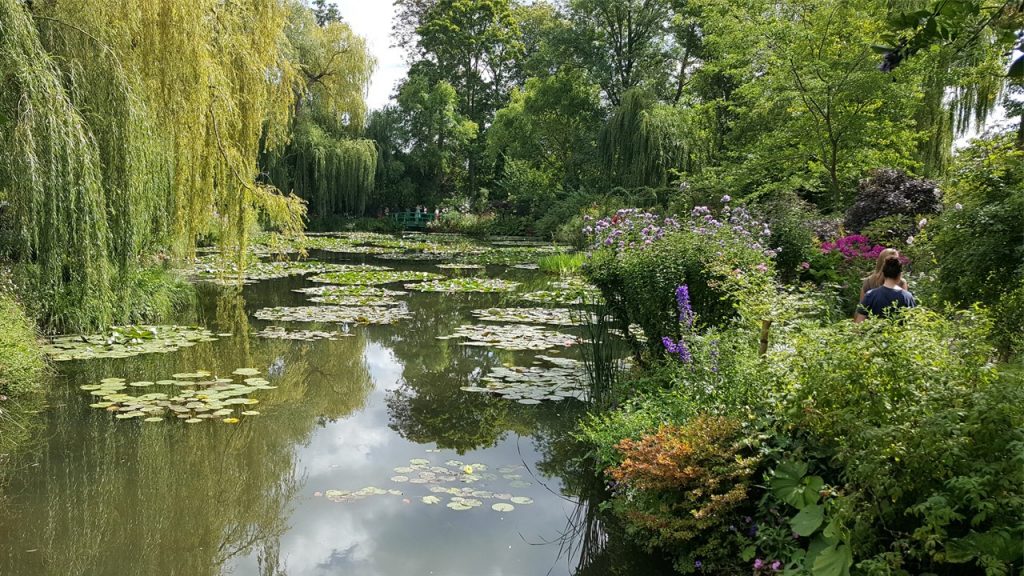
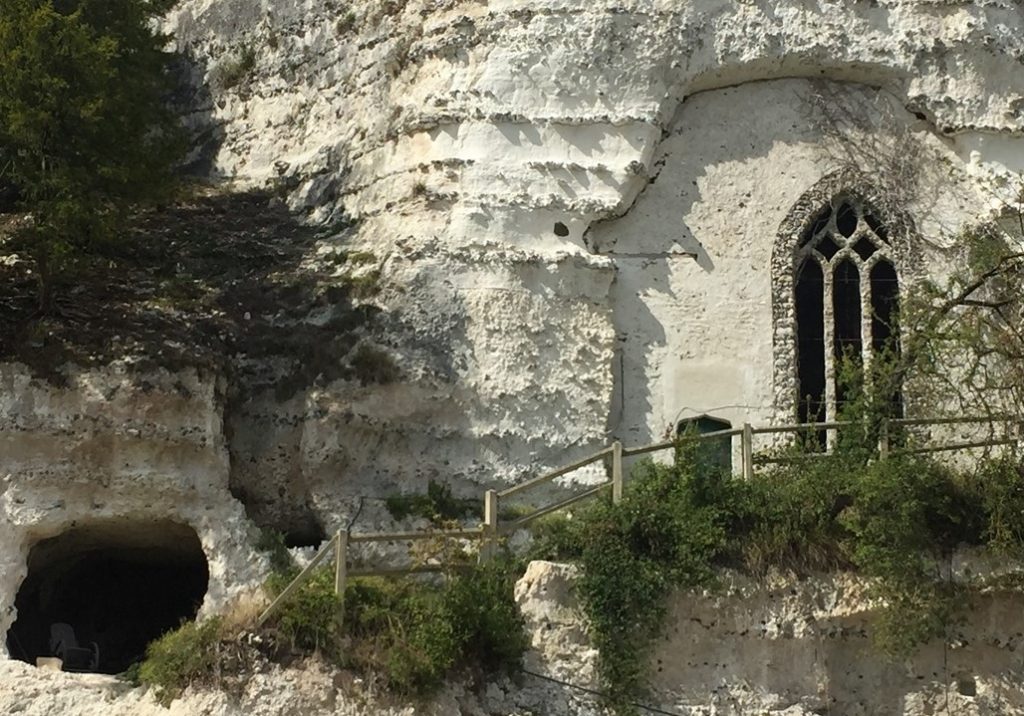
The ship reaches Conflans at about 7:00am, and after breakfast, our group meets onshore to review today’s route that includes gravel and some rough off-road portions. Once prepared, we begin our 10-mile bicycling trip along the shores of the Oise River to the town of Auvers-sur-Oise and the last home of Vincent’s Van Gogh and where he spent the last 70-days of his life. The Auberge Ravoux is a French historic landmark located in the heart of the village and where van Gogh was a lodger. During his short stay at Auvers, Van Gogh created more than 80 paintings and 64 sketches before supposedly shooting himself (?) in the chest on 27 July 1890 and dying two days later. We tour the old house, take time to visit the local cathedral, and have a relaxing coffee at the Absinth House before re-boarding our bicycles and setting off on a scenic 9-mile loop past the Van Gogh brothers’ graves and across the rolling hillside and meadows before returning to Auvers for a final bicycling picnic. From here, it’s a return 10-mile ride back to the ship and saying a final goodbye to our bicycles and our guides Carlos and Clem. We clean-up for a spectacular lunch in the dining room highlighted by mussels and oysters on the half shell, and a subsequent afternoon ice cream social up on deck as the ship leaves Conflans and heads for Paris. In the afternoon, we repack most of our belongings and prepare for our last night aboard. At dinner time, our group takes over the Chef’s Table Dining Room for a special group 7-course French dinner and a chance to socialize with each other and with our Backroads guides, Otis and James. The ship arrives back in Paris at ~9:00pm, and we promptly all take our drinks up on deck as we sail along the Seine and watch the sparkling light show on the majestic Eiffel Tower. It’s a beautiful and perfect end to a wonderful trip, as we head back our room for a good night’s sleep.


The next morning, we set our luggage out, have a good breakfast, say our final goodbyes, and board our taxi for the Charles de Gaulle Airport. It has been an exciting and informative adventure that we are very glad we did.
